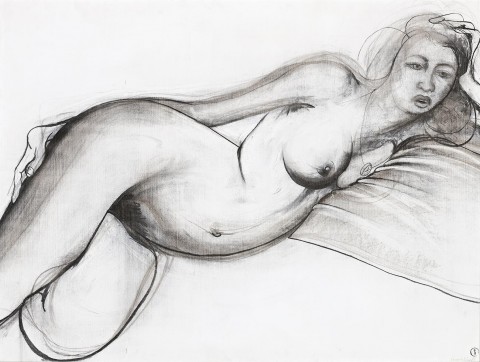NUDE AND NECKLACE, 1978
BRETT WHITELEY
oil and mixed media on canvas on board
80.5 x 106.0 cm
signed and dated lower right: brett whiteley 78
artist's stamp lower right
Macquarie Galleries, Sydney
Savill Galleries, Sydney
Christie’s, Sydney, 17 August 1999, lot 174
Art Galleries Schubert, Queensland (label attached verso)
Private collection, New South Wales
Deutscher~Menzies, Melbourne, 2 September 2003, lot 39
Private collection, Victoria
On long-term loan to Bendigo Art Gallery, Victoria, 2003 – 2018
For Brett Whiteley, a deep appreciation of the sensuality of the human form permeated every aspect of his life and art. Recognised by art critic Bryan Robertson during Whiteley’s early years in London as ‘a level of sexual and sensual sophistication rare in an artist so young’1, indeed this predisposition would ultimately underpin and inspire his entire creative oeuvre. Without doubt however, it is in the myriad of paintings, drawings, sculptures and etchings dedicated to the female nude that Whiteley most thoroughly and adeptly manifests his abiding preoccupation with the sensual and tactile – exploiting the expressive and abstract possibilities of the genre to create some of the most erotic nudes ever conceived by an Australian artist. Clearly, Whiteley also considered the subject ‘predominant really … a very major part of my work’2, elaborating thus ‘… If genius is the atheist’s word for God … then the attempt to visualise the great nude would be the highest point of creation, for perfection is impossible, and no distortion can be extreme enough’.3
Exemplifying this sheer delight in the beauty of the female form, Nude and Necklace, 1978 was executed at the pinnacle of Whiteley’s career, with the artist awarded all three of Australia’s most prestigious art prizes that same year (The Archibald Prize for portraiture; the Wynne Prize for landscape painting; and the Sulman Prize for genre painting) – an achievement yet to be surpassed.4 Exuding a sense of languid, sensual pleasure that evokes unmistakable parallels with the reclining odalisques of his artistic mentors such as Matisse, the composition also echoes Whiteley’s own earlier ‘Bathroom series’ – his first consolidated depictions of the nude which celebrated his love for his new wife and muse, Wendy, and heralded his breakthrough as an accomplished draughtsman of the figure. Now, however, the erotic is made arguably more explicit in the model’s provocative frontality – dominating the picture plane, she is voluptuous, fecund and overtly sexual. With its extraordinary economy of line, gentle tonal modulations and palpable sensuality, the work is a superb example of Whiteley’s lifelong quest to visualise the ‘perfect’ nude; as the artist himself wrote with characteristic irreverence in catalogue notes accompanying an exhibition of comparable nudes in 1981,
‘… most men, and certainly all artists, even if many never get around to actually painting it, carry in their heads the great nude. The Venus, the Bathsheba, the Bather, Diana, even the great centrefold, he carries all his life the idealisation, carries it like some little uncut gem in his mind, waiting there to be given form. Filtering down through civilisation is the urge to show this glimpse of beauty, where invention and skin become one, and the history of art marries the whole history of one’s sex. Mistress, mother, lover, whore, obtainable – unobtainable, it is the wonder of a perfect distortion’.5
1. Robertson, B., cited in McKenzie, J., ‘Obituary: Brett Whiteley’, ‘Divided Self, Sweeping Line’, The Guardian, 18 June 1992, n.p.
2. Whiteley, B., cited in Don Featherstone's film Difficult Pleasure: A Portrait of Brett Whiteley, 1989
3. Whiteley, B., ‘Recent Nudes’, exhibition catalogue, Artist’s Studio, Sydney, 1981, n.p.
4. Whiteley won The Archibald Prize with Art, Life and The Other Thing, 1978; The Wynne Prize with Summer at Carcoar, 1978; and The Sulman Prize with Yellow Nude, 1978.
5. Whiteley, B., ibid.
VERONICA ANGELATOS
